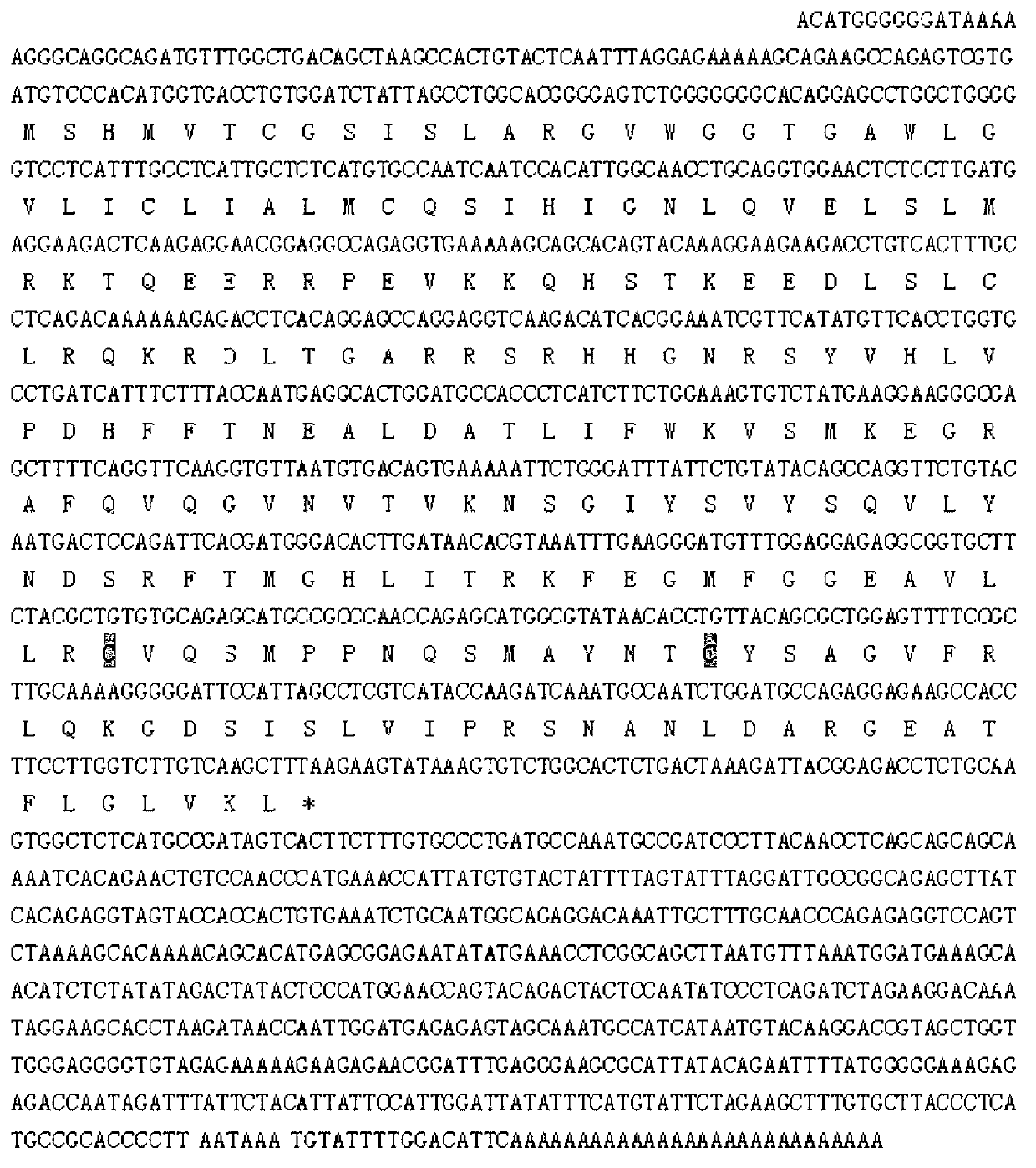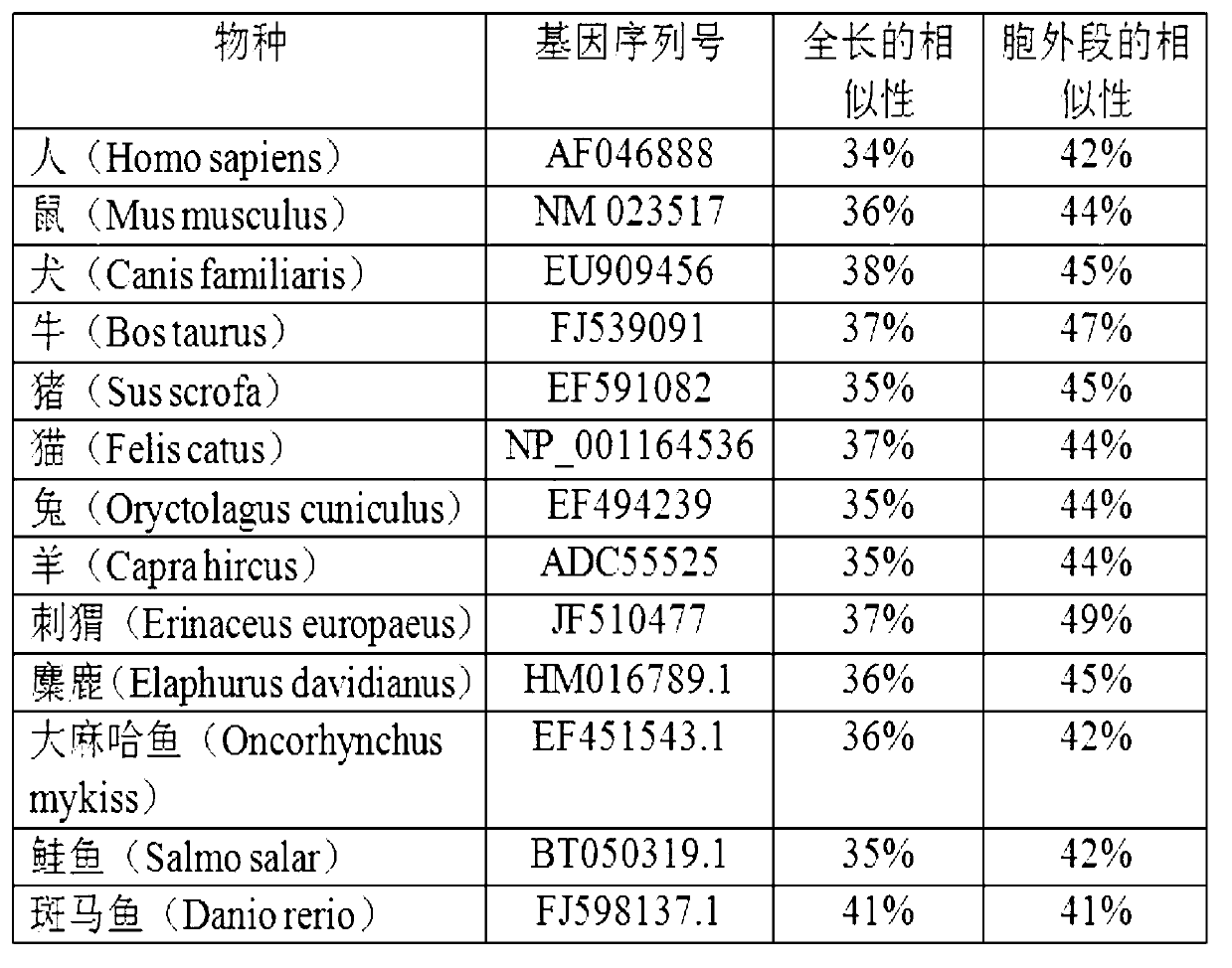Preparation and application of African clawed frog proliferation induction ligand TNFSF13 gene and protein
A technology of Xenopus laevis and ligands, applied in DNA preparation, application, genetic engineering and other directions, can solve the problem of not being cloned
- Summary
- Abstract
- Description
- Claims
- Application Information
AI Technical Summary
Problems solved by technology
Method used
Image
Examples
Embodiment 1
[0042] African clawed frogs were purchased from the Model Animal Genetics Center of Nanjing University
[0043] (1) Extraction of total RNA: The total RNA of Xenopus frog spleen tissue was extracted using the animal tissue RNA extraction kit (TIANGEN) according to the operation manual, and its quality and purity were identified by formaldehyde-denatured agarose gel electrophoresis, and its quality and purity were determined by ultraviolet spectrophotometer. concentration. SMARTTM RACE Kit (TaKaRa) was reverse transcribed into the first strand of cDNA, and the templates of 5'RACE and 3'RACE were done separately. The reaction process of 5'RACE reverse transcription: 1.75μl RNA, 1.0μl 5'-CDS Primer A, 1.0μl sterile water, mix and centrifuge, incubate at 72°C for 3min, incubate at 42°C for 2min, after cooling, spin at 14000g for 10 seconds, then Add 1.0μl SMARTer Ⅱ Aoligo, 2.0μl 5×First-Strand Buffer, 1.0μl DTT (20mM), 1.0μl dNTP Mix (10mM), 0.25μl RNase Inhibitor (40U / μl), 1.0μl...
Embodiment 2
[0053] Construction of recombinant expression vector of Xenopus APRIL and its induced expression in Escherichia coli, purification and identification;
[0054] Primers Xs-F and Xs-R were designed according to the known sequence of APRIL to amplify the soluble segment of the gene. Among them, the 5' end of Xs-F has a StuI restriction site, and the 5' end of Xs-R has an XhoI restriction site. The first-strand cDNA of Xenopus frog is used as a template, and Xs-F and Xs-R are used as primers (Xs -F5'-TGACCTCACAGGAGCCAGGA-3'(SEQ ID NO.18), Xs-R5'-CCGCTCGAG TTAAAGCTTGACAAGACCAAGGA-3'(SEQ ID NO.19)), PCR amplification of the functional region of the gene (10×dreamTaq Buffer 5μl, dNTP ( 2.5mM) 8μl, Xs-F (10μmol / L) 2μl, Xs-R (10μmol / L) 2μl, H2O30.5μl, cDNA 2μl, dream Taq0.5μl) The reaction conditions are as follows: 94°C 5min, (94°C30s, 60 °C30s, 72°C1min), 30 cycles, and finally extended at 72°C for 7min. After that, the PCR product was recovered by tapping the gel. The recovered pro...
Embodiment 3
[0059] The effect of SUMO-XsAPRIL on promoting survival / proliferation of mouse B lymphocytes was detected in vitro;
[0060] Mouse B lymphocytes were isolated by magnetic beads (Miltenyi Biotech). Use RPMI1640 (10%FCS, 100U / ml Penicillin / streptomycin) medium to adjust the cell concentration to 2×10 6cells / ml, add 100 μl cell suspension to each well of a 96-well plate, place at 37°C, 5% CO 2 Adapt to the cell culture incubator for 3-4 hours. The recombinant protein SUMO-XsAPRIL was added in groups sequentially, and the final concentration of the recombinant protein was 0.5, 1, 2, 4, 6, 8, 10, 12 μg / ml in sequence, with PBS, SUMO, anti-IgM, mouse APRIL protein (msAPRIL) as comparison. Placed in an incubator for 48 hours. After 48 hours, 10 μl of WST-8 was added to each well of the 96-well plate and incubated for 1 hour. Measure the absorbance at 450 nm with a microplate reader. The results showed that SUMO-XsAPRIL could significantly promote the survival / proliferation of B...
PUM
 Login to View More
Login to View More Abstract
Description
Claims
Application Information
 Login to View More
Login to View More - R&D Engineer
- R&D Manager
- IP Professional
- Industry Leading Data Capabilities
- Powerful AI technology
- Patent DNA Extraction
Browse by: Latest US Patents, China's latest patents, Technical Efficacy Thesaurus, Application Domain, Technology Topic, Popular Technical Reports.
© 2024 PatSnap. All rights reserved.Legal|Privacy policy|Modern Slavery Act Transparency Statement|Sitemap|About US| Contact US: help@patsnap.com










